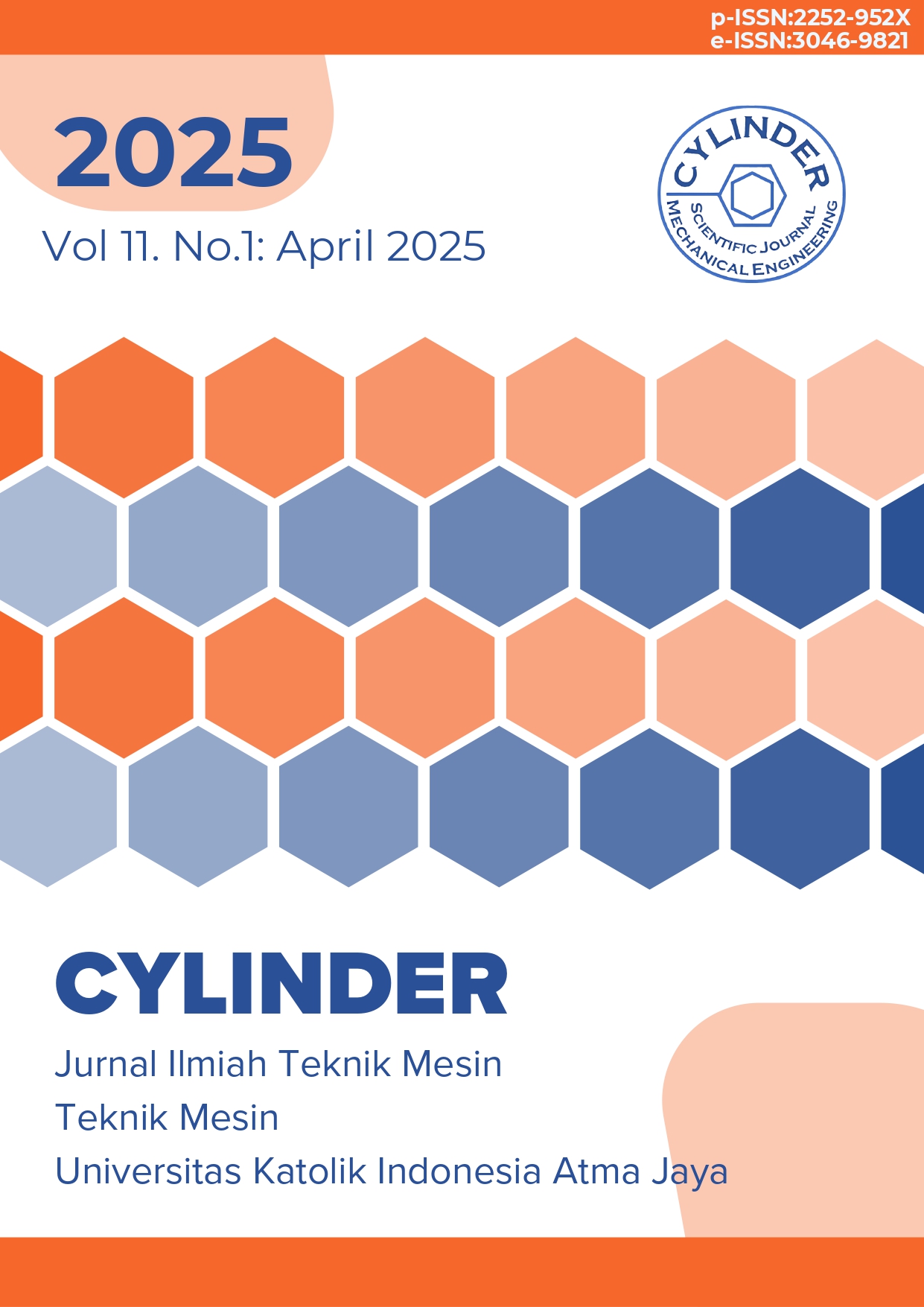Rancang Bangun Alat Uji Kekuatan Material Polimer dan Komposit Polimer Berpenguat Serat Alam
DOI:
https://doi.org/10.25170/cylinder.v11i1.6648Keywords:
Akrilik, Alat uji tarik, Komposit polimer, Plexiglas, PolimerAbstract
Current engineering technology places great emphasis on efficient and energy-saving construction. Nowadays, research and development of engineering materials are more directed at relatively strong, stable and lightweight materials. Polymers and natural fiber reinforced polymer composites are one of those that can meet these needs and are being researched. To achieve optimal results, the research must be supported by appropriate test equipment that can properly characterize the materials being developed. This research aims to design a mechanical and electrical tensile testing device especially for polymers and polymer composites. The research produced a prototype of a tensile testing device that has a maximum load capacity of 20.25 kN. The success of this research is proven by the strength of PMMA, which was tested using this device. The test results showed that PMMA has a tensile strength of about 58.2 and 60.7 MPa. This value is within the range of PMMA strength obtained from the literature.
References
[1] B.H. Lee, H.J. Kim and W.R. Yu, "Fabrication of long and discontinuous natural fiber reinforced polypropylene biocomposites and their mechanical properties," Fibers Polym vol. 10, pp. 83-90, 2009.
[2] S. Satapathy and R.V.S. Kothapalli, "Mechanical, dynamic mechanical and thermal properties of banana fiber/recycled high density polyethylene biocomposites filled with flyash cenospheres," J. Polym. Environ., vol. 26, pp. 200-213, 2018.
[3] L. Jiang, J. Fu, L. Liu and P. Du, "Wear and thermal behavior of basalt fiber reinforced rice husk/polyvinyl chloride composites," J Appl Polym Sci., vol. 138, no. 13, 2020.
[4] M.S. Gupta and E. Jha, "Review on Evaluation of properties of carbon phenolic composite structure using gas chromatography for analysis of thermal performance," in IOP Conference Series: Mater. Sci. Eng., vol.455, 2018.
[5] K. Sałasinska, M. Kirpluks, P. Cabulis, A. Kovalovs, E. Skukis, P. Kozikowski, M. Celinski, K. Mizera, M. Gałecka, K. Kalnins, et al, "Experimental Investigation of the Mechanical Properties and Fire Behavior of Epoxy Composites Reinforced by Fabrics and Powder Fillers," Processes, vol. 9, no. 5, pp. 1-20, 2021.
[6] G.R. Reddy, M.A. Kumar, N. Karthikeyan and S.M. Basha, "Tamarind fruit fiber and glass fiber reinforced polyester composites," Mech. Adv. Mater. Struct. vol. 22, pp. 770-775. 2015.
[7] O. Suparno, "Potensi dan masa depan serat alam Indonesia sebagai bahan baku aneka industri," Juranl Teknologi Industri Pertanian, vol. 30, no. 2, pp. 221-227, 2020.
[8] A. Gholampour and T. Ozbakkaloglu, "A review of natural fiber composites: properties, modification and processing techniques, characterization, applications," J Mater Sci," vol. 55, pp. 829–892, 2020.
[9] H. Hajnalka, I. Racz and R.D. Anandjiwala, "Development of HEMP fibre reinforced polypropylene composites," J Thermoplast Compos Mater, vol. 21, pp. 165–174, 2008..
[10] X. Ma, J. Yu and J.F. Kennedy, "Studies on the properties of natural fibres-reinforced thermoplastic starch composites." Carbohydr Polym, vol. 62, no. 1, pp. 19–24, 2005.
[11] D20 Committee, “Test Method for Tensile Properties of Plastics,” ASTM International. doi: 10.1520/D0638-14.
[12] Massachusetts Institute of Technology, “Material: PMMA,” https://www.mit.edu/~6.777/matprops/pmma.htm.
Downloads
Published
How to Cite
License
Copyright (c) 2025 Widodo Widjaja Basuki, Ferry Rippun G Manalu

This work is licensed under a Creative Commons Attribution 4.0 International License.

